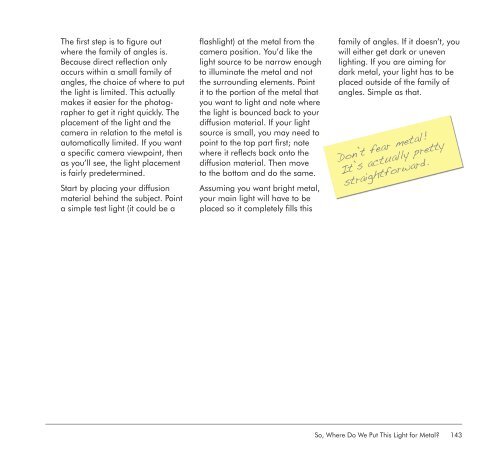Focus On Lighting Photos Focus on the Fundamentals.pdf
You also want an ePaper? Increase the reach of your titles
YUMPU automatically turns print PDFs into web optimized ePapers that Google loves.
The first step is to figure out<br />
where <strong>the</strong> family of angles is.<br />
Because direct reflecti<strong>on</strong> <strong>on</strong>ly<br />
occurs within a small family of<br />
angles, <strong>the</strong> choice of where to put<br />
<strong>the</strong> light is limited. This actually<br />
makes it easier for <strong>the</strong> photographer<br />
to get it right quickly. The<br />
placement of <strong>the</strong> light and <strong>the</strong><br />
camera in relati<strong>on</strong> to <strong>the</strong> metal is<br />
automatically limited. If you want<br />
a specific camera viewpoint, <strong>the</strong>n<br />
as you’ll see, <strong>the</strong> light placement<br />
is fairly predetermined.<br />
Start by placing your diffusi<strong>on</strong><br />
material behind <strong>the</strong> subject. Point<br />
a simple test light (it could be a<br />
flashlight) at <strong>the</strong> metal from <strong>the</strong><br />
camera positi<strong>on</strong>. You’d like <strong>the</strong><br />
light source to be narrow enough<br />
to illuminate <strong>the</strong> metal and not<br />
<strong>the</strong> surrounding elements. Point<br />
it to <strong>the</strong> porti<strong>on</strong> of <strong>the</strong> metal that<br />
you want to light and note where<br />
<strong>the</strong> light is bounced back to your<br />
diffusi<strong>on</strong> material. If your light<br />
source is small, you may need to<br />
point to <strong>the</strong> top part first; note<br />
where it reflects back <strong>on</strong>to <strong>the</strong><br />
diffusi<strong>on</strong> material. Then move<br />
to <strong>the</strong> bottom and do <strong>the</strong> same.<br />
Assuming you want bright metal,<br />
your main light will have to be<br />
placed so it completely fills this<br />
family of angles. If it doesn’t, you<br />
will ei<strong>the</strong>r get dark or uneven<br />
lighting. If you are aiming for<br />
dark metal, your light has to be<br />
placed outside of <strong>the</strong> family of<br />
angles. Simple as that.<br />
D<strong>on</strong>’t fear metal!<br />
It’s actually pretty<br />
straightforward.<br />
So, Where Do We Put This Light for Metal? 143



